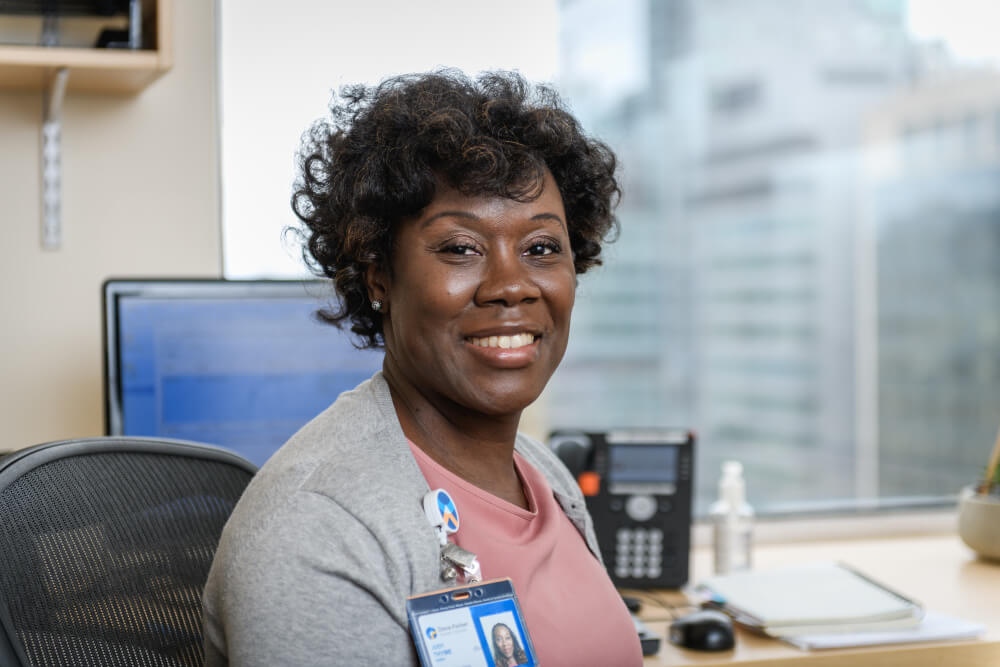Throughout her nearly 20-year career at Dana-Farber, Judy Thyme has enjoyed forming close bonds with patients. Most recently, she has been making these connections earlier than ever — in some cases ensuring new patients make it to their first appointment.
Thyme is a community-focused patient navigator, a position developed during the past two years as part of Dana-Farber’s Cancer Care Equity Program (CCEP) The CCEP has worked in Greater Boston neighborhoods for more than a decade addressing persistent health inequities and barriers to obtaining cancer screening, diagnostic workups, and treatment, and the new navigators take additional steps to support oncology patients from historically marginalized communities in accessing timely care throughout the cancer continuum.
Through their efforts, Thyme and other community-focused patient navigators help patients overcome food insecurity, lack of transportation to and from appointments, and other social determinants of health. In doing so, they are building upon a successful model: Dana-Farber’s Patient Navigator Program, which since 2005 has assisted individuals facing logistical, financial, and other barriers to cancer care.
Each day, Thyme runs a report to identify newly-diagnosed Thoracic Oncology patients residing in Roxbury, Dorchester, Mattapan, and Jamaica Plain — four Boston neighborhoods with some of the city’s most historically marginalized populations. She then contacts each new patient, welcomes them to the Dana-Farber Brigham and Women’s Cancer Center community, and explains what they can expect at their first appointment. By seeking to understand each patient’s life context, she can better identify potential barriers to that individual’s ability to access care.
Next comes Thyme’s favorite part of the process. Greeting patients at their initial on-site visits, she guides them through each stage of their first day. This includes sitting in on the patient’s first consultation with their Dana-Farber care team and taking notes for the patient if needed.
“I’ve always had the desire to work with people to help them set their goals, and provide them with resources and support to reach those goals,” says Thyme, who worked in patient scheduling before assuming her navigator role. “My previous patient relationships were primarily on the phone, so it’s wonderful to offer them this new level of intimacy. Patient navigation is like patient advocacy on steroids.”

There for anything
Part of her role as a navigator, Thyme explains, is being a keen observer. She conducts a thorough chart assessment of each patient to better understand their medical and social histories and identify support services that could help them.
If, for instance, she discovers a patient is “paying out of pocket” for a procedure, she will check to see if they lack health insurance — and, if so, connect them with the Patient Financial Assistance program. If they struggle with English during an initial call, or report an unhealthy diet, she can reach out to Interpreter Services or Nutrition Services. Signs of anxiety or depression might prompt a referral to a social worker within the Department of Psychosocial Oncology and Palliative Care.
“I’m there to help with anything: transportation, food, anything that would hinder them from coming to their appointments and being successful in treatment,” says Thyme. “I am able to follow them from the moment they come to Dana-Farber until survivorship or end-of-life.”
And, just as she did when working as a scheduler, Thyme calls to remind patients about upcoming appointments. They know she’s always available to answer questions, and if they don’t show up for a visit, she checks in to make sure they are OK — and help reschedule the visit.
There is one barrier to care that Thyme says can be particularly challenging: helping new patients embrace cancer treatment as a road to recovery. Oftentimes patients from historically marginalized communities can be mistrusting of the healthcare system. They see a cancer diagnosis as a death sentence, so building trust with them begins with Thyme’s first call.
“You have patients fearful of the outcome,” says Thyme. “I need to reassure them that they are going to get the best in care, with a multidisciplinary team that is looking at every part of their treatment and working together as one.”
Expanding access
Thyme is one of three community-facing patient navigators at Dana-Farber; Fabia Federico works with Gastrointestinal Oncology patients, and Marlene Escobar works with Breast Oncology patients. The program was developed by Vice President of Community Health Magnolia Contreras, MSW; Associate Chief Medical Officer Christopher Lathan, MD, MS, who is also chief clinical access and equity officer and medical director of the network; and Ludmila Svoboda, RN, BSN, nurse director of the Cancer Care Equity Program. The team is working on replicating the initiative in other disease centers at Dana-Farber Brigham.
“It is an incredible opportunity to serve the most historically marginalized patients right in our own backyard,” says Svoboda. “This program helps us level the playing field and ultimately decrease disparities in cancer outcomes.”
The team envisions a Comprehensive Patient Supportive Services Model in which community-facing patient navigators partner with oncology nurse navigators, social workers, resource specialists, and telehealth coordinators to deliver patient-centered care. By connecting with patients at the point of diagnosis, and creating referral networks with community health centers that help eliminate barriers to entry, the new navigator program is designed to help ensure more of underserved individuals get to Dana-Farber Brigham.
“If we all work well together, there will be less opportunity for these patients to fall through the cracks,” says Contreras. “Our goal is to expand clinical access so that they have the same positive outcome that so many other patients have at Dana-Farber, and recognize that there is a survivorship opportunity for them.”
